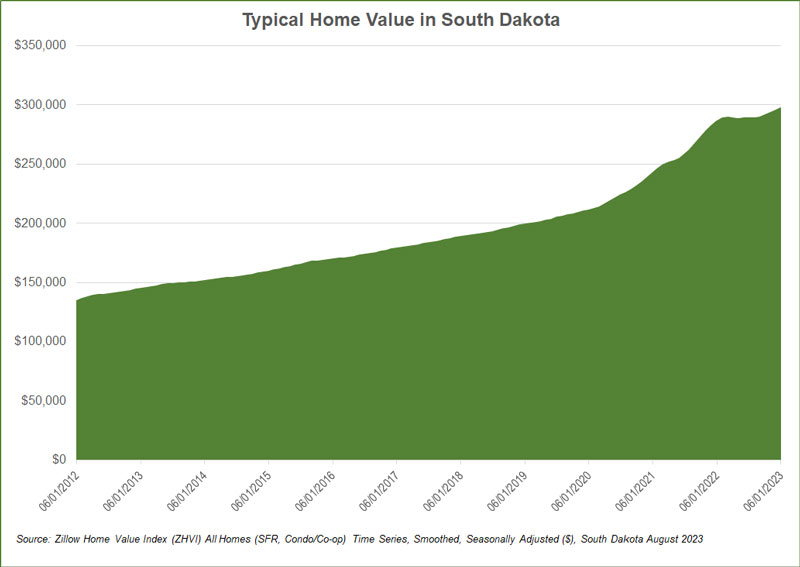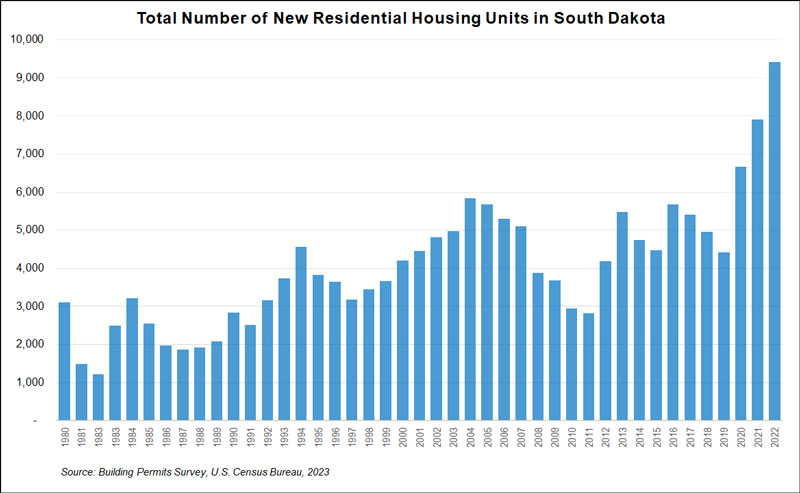- Home to LMIC
- Virtual Labor Market Data System
- Career Exploration & Planning
- Consumer Price Index
- Demographics
- Economic Snapshot
- Employee Benefits
- Employment Projections
- Labor Force & Unemployment
- Labor Supply
- Overview of the Current Labor Market
- Surveys We Conduct
- Wages & Income
- Workers by Industry
- Tools & Resources
- Publications
- References
- What's New
- Can't Find It?
South Dakota e-Labor Bulletin
August 2023
South Dakota’s Construction Sector: part of South Dakota's economic foundation
The Construction industry plays a significant role in South Dakota’s economy and helps facilitate population and economic growth. Over the last several years, the state’s population has been growing, increasing the demand for residential and commercial housing. In turn, the construction industry increases job opportunities and raises the demand for workers. According to the Census Bureau’s population estimates, South Dakota experienced a 2.5% population increase from 2020 to 2022. South Dakota’s population growth rate since 2020 has been higher than that of the United States (0.5%) and the Midwest Region (-0.3%).
| Annual Estimates of the Resident Population for the United States, Midwest Region and South Dakota |
||||
| Area | 2020 | 2022 | Actual Change | Percent Change |
| United States | 331,511,512 | 333,287,557 | 1,776,045 | 0.5% |
| Midwest | 68,961,043 | 68,787,595 | -173,448 | -0.3% |
| South Dakota | 887,799 | 909,824 | 22,025 | 2.5% |
| Source: U.S. Census Bureau | ||||
The state's expanding population goes hand in hand with a growing economy and an increasing number of workers within the Construction industry.
Taking a more macroeconomic look, the Construction sector’s worker levels in South Dakota historically have been increasing since 2001, apart from the 2008 recession. From 2001 until 2008, the number of Construction workers increased by 3,779 workers or 20.5%. The recession hit the Construction industry in 2008; however, since then the number of workers has been steadily increasing. Over the past 10 years (2012-2022) worker levels have averaged a gain of 547 workers each year. The largest increase occurred from 2021 to 2022 at 4.0%.
Several factors contributed to the faster growth in recent years. The pandemic of 2020 had more residents working from home and needing to improve their living/working spaces. Not only were a lot of remodels happening, but many individuals were purchasing real estate as interest rates remained at historic lows in 2020 and 2021. During the pandemic, South Dakota attracted out-of-state families, making the housing market even tighter with limited inventory. The supply has been outpaced by the demand recently, which is reflected in the increased typical home value.

According to Zillow Group’s Home Value Index (ZHVI), as of June 2023 South Dakota’s typical home value was $296,108.61. The ZHVI is a measure of the typical home value and market changes across a given region and housing type. It reflects the typical value for homes in the 35th to 65th percentile range. The index is available as both a smoothed, seasonally adjusted measure and as a raw measure. The ZHVI in South Dakota has risen $97,873 or 49.4% from June 2019 to June 2023.
Housing has a direct relationship with the Construction industry, and price mirrors supply in the market. The need remains to increase the availability of houses to catch up with the demand. South Dakota achieved the second largest percent increase in the number of new housing units in the nation from 2020-2022 at 41.5%, according to the Census Bureau. According to the National Association of Realtors' South Dakota Housing Report for May 2023, the median sales price of a house was estimated at $226,570. The number of listings increased 9.7% over the year.

A hot housing market over the last several years has created a need for workers within the Construction sector. Businesses within Construction are defined by the North American Industry Classification System (NAICS). From a more microeconomic view, the Construction sector is divided into three subsectors.
- The Construction of Buildings (NAICS 236) subsector includes establishments performing new work, additions, alterations, maintenance and repairs.
- Establishments in Heavy and Civil Engineering Construction (NAICS 237) primarily construct entire engineering projects.
- Specialty Trade Contractors (NAICS 238) perform specialized activities involved in building construction, such as pouring concrete, site preparation, plumbing, painting, etc. Specialty trade contractors usually perform most of their work at the construction site, although they may have shops where they perform prefabrication and other work.
Data from the Quarterly Census of Employment and Wages (QCEW) program operated in cooperation with the U.S. Bureau of Labor Statistics provides industry trends on number of establishments, employment levels and pay. (Only employment covered by unemployment insurance in South Dakota is included in the QCEW program.) QCEW shows South Dakota’s Construction industry showed an increase of 996 workers or 4.0% during 2022. The number of establishments increased by 155, bringing the total to 4,491 establishments in 2022. The average annual pay increased by $3,072 or 5.5%, bringing the average annual pay to $58,955 in 2022. South Dakota’s Construction sector ranked 10th in annual pay among all sectors in 2022. From 2021 to 2022, this industry ranked fifth overall in employment and contained the second-highest number of establishments of all sectors.
Annual pay increased in all three subsectors:
- Construction of Buildings increased by $4,031 or 7.8%
- Heavy and Civil Engineering increased by $4,877 or 6.9%
- Specialty Trade Contractors increased by $2,422 or 4.5%
The number of establishments increased in two of the three subsectors over the past year, and the overall sector added 155 establishments. The Specialty Trade Contractors subsector added the most establishments with 114, followed by Construction of Buildings which added 44 new businesses. The Heavy and Civil Engineering Construction subsector lost three establishments in 2022.
Two of the three subsectors under the Construction sector increased worker levels from 2021 to 2022. The Specialty Trade Contractors added the most workers with an additional 822 workers or 5.6%, and Construction of Buildings followed with an increase of 222 workers or 3.6%. The Heavy and Civil Engineering Construction subsector decreased by 48 workers or 1.1%
The need for workers in Construction remained significant as of 2022 in South Dakota. With continued population growth comes the added need for housing and commercial buildings, which in turn increases the workforce requirements in the Construction sector. Over the next few years, demand should remain strong due to a growing population and deficit in available homes compared to the demand brought by the buyers.
South Dakota industry employment projections for the 2020 to 2030 timeframe show the Construction industry is expected to have sustained growth. The number of workers in the industry is projected to increase by 10% or 2,447 workers by 2030. The projected figures consider several economic indicators, most importantly historical employment data from the QCEW program. The projections methodology does not account for major unforeseen events such as war, pandemics or a catastrophe that can significantly alter employment or employment patterns. Uncertainties in the market exist due to the previous pandemic, interest rates, consumer expectations and population growth; however, if the demand for real estate continues to exceed supply, worker levels are expected to continue rising based on recent historical trends within the Construction industry.
